The Common Loon, the Great Northern Diver, is a captivating waterbird in North America’s freshwater lakes and ponds.
Renowned for its striking black-and-white plumage, haunting calls, and expert diving abilities, the Common Loon holds a prominent place in the region’s natural heritage.
For generations, this iconic bird’s fascinating biology and behaviors have intrigued birdwatchers, scientists, and nature enthusiasts.
From its migratory journeys to its devoted parental care and vital role in aquatic ecosystems, the Common Loon inspires awe and wonder. Stay sharp.
Physical Characteristics of Common Loon
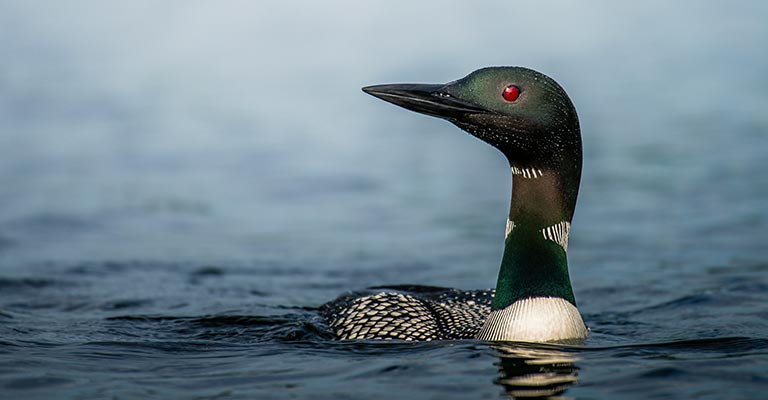
The Common Loon (Gavia immer) is a striking and iconic bird species in freshwater lakes and ponds across North America. Here are some of the fundamental physical characteristics to help you identify this majestic bird:
Size and Shape
Common Loons are large waterbirds, measuring around 28 to 36 inches long with a wingspan of about 4 to 5 feet. They have a sleek, streamlined shape, long body and neck, and a distinctive pointed bill.
Plumage
During the breeding season, adult Common Loons exhibit striking black-and-white plumage. Their head and neck are glossy black, contrasting sharply with striking white stripes and spots on their neck and back.
Their underside is predominantly white. Outside the breeding season, their plumage becomes more muted, with a grayish-brown coloring.
Red Eyes
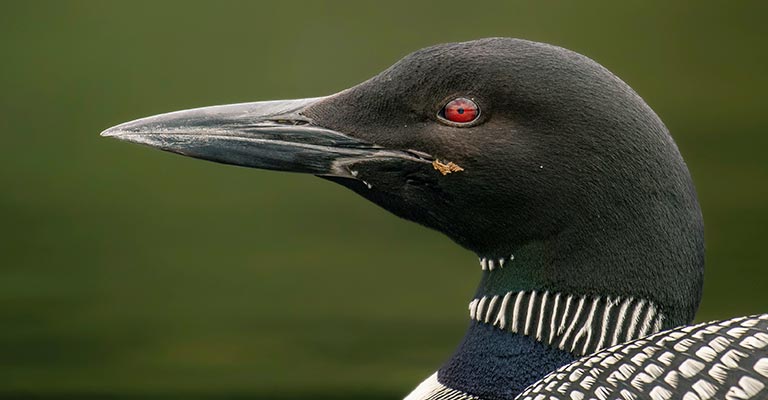
One of the most noticeable features of a Common Loon is its striking red eyes. These crimson orbs stand out prominently against the bird’s black head, providing a dramatic contrast.
Bill
Common Loons have long, dagger-like bills that are slightly upturned. Their bills are primarily black, with a pale band near the tip. This distinctive bill shape is adapted for catching fish, their primary prey.
Voice
Common Loons are famous for their haunting, eerie calls that echo across the lakes where they reside. Their vocalizations include yodels, wails, and tremolos, which they use for communication and territory defense.
Their unmistakable calls can help identify their presence even if they are not immediately visible.
Flight Pattern
When in flight, Common Loons exhibit a characteristic profile. They fly with their necks outstretched, often low over the water’s surface.
Their wings are mighty and make deep, slow beats, giving them a distinctive and graceful flight pattern.
Diving Behavior
Common Loons are expert divers, spending much of their time underwater searching for fish. Their diving behavior is another clue for identification.
They dive with a slight leap forward, disappearing beneath the water’s surface for extended periods before resurfacing at a different location.
Habitat
Finally, understanding the habitat preferences of Common Loons can aid in identification.
They are typically found in large, clear, freshwater lakes with abundant fish populations. Look for them in remote, forested areas with minimal human disturbance.
The Common Loon is a remarkable bird with several distinctive physical characteristics that make it relatively easy to identify.
From its striking black-and-white plumage and red eyes to its haunting calls and diving behavior, there are many features to look for when spotting this iconic bird on North American lakeshores.
Taxonomy of Common Loon
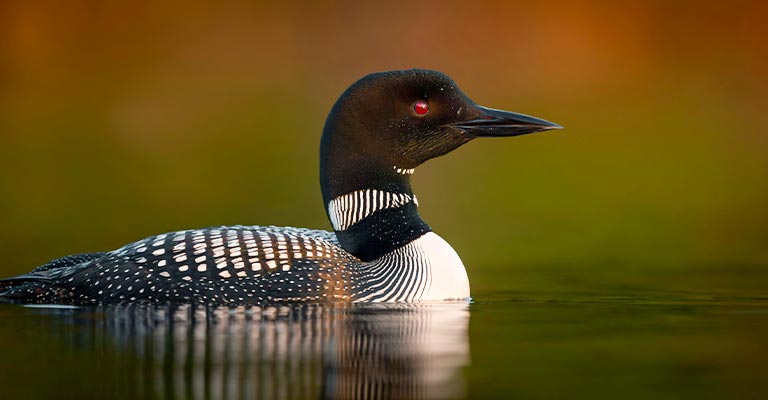
Go through the table below detailing the taxonomy details of the Common Loon:
| Taxonomic Rank | Classification |
| Domain | Eukaryota |
| Kingdom | Animalia |
| Phylum | Chordata |
| Class | Aves |
| Order | Gaviiformes |
| Family | Gaviidae |
| Genus | Gavia |
| Species | G. immer |
The Common Loon (Gavia immer) belongs to the family Gaviidae, which comprises four species of loons. Loons are large, aquatic birds with sleek bodies, dagger-like bills, and exceptional diving abilities.
They are part of the order Gaviiformes, a small group of birds adapted for life on freshwater lakes and coastal waters.
Gaviidae is further classified into the genus Gavia, with the Common Loon being one of its most well-known members.
Taxonomically, the Common Loon is classified within the animal kingdom (Animalia), phylum Chordata, class Aves (birds), and order Gaviiformes.
Understanding the taxonomy of the Common Loon helps scientists categorize and study its evolutionary relationships and ecological roles within aquatic ecosystems.
Hunting Habit of Common Loon
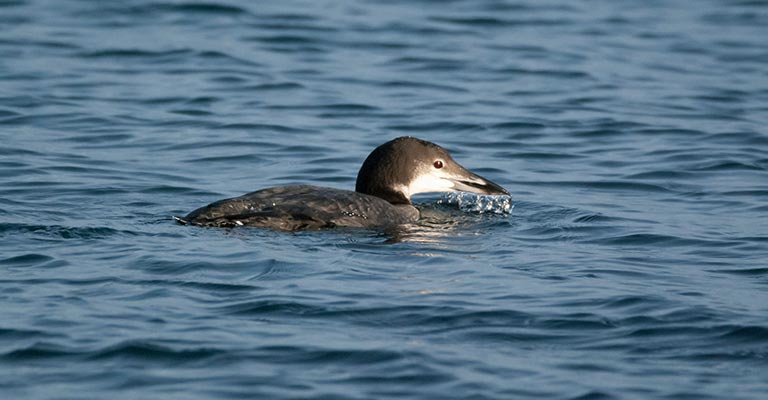
The Common Loon is an adept and specialized hunter, primarily preying on fish. Using its streamlined body and powerful legs, the loon dives underwater, propelling itself with its feet and wings to pursue fish.
Its long, dagger-like bill is perfectly adapted for grasping and holding onto slippery prey. Common Loons are skilled divers, capable of staying submerged for extended periods, aided by their high oxygen capacity and ability to reduce their heart rate.
They typically hunt alone or in pairs, diving from the surface and resurfacing at a different location. Their hunting strategy involves stealth and patience, as they silently stalk their prey underwater before striking precisely.
This behavior underscores the Common Loon’s status as a formidable predator in its aquatic environment.
Common Loon Life History
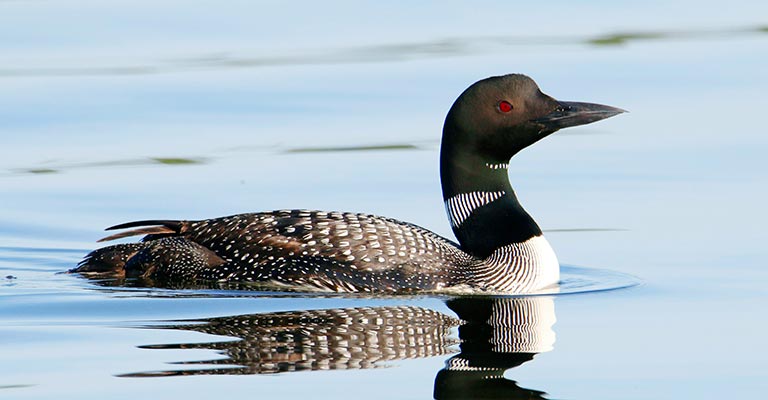
The Common Loon (Gavia immer) is a fascinating waterbird with a rich history.
From its hunting habits and breeding behaviors to its conservation status and interaction with diseases, the Common Loon’s life is a testament to adaptability and resilience.
Food
Common Loons primarily feed on fish, favoring perch, sunfish, and trout species. They are skilled divers, capable of plunging to impressive depths in pursuit of prey.
Their diet may include crustaceans, amphibians, and occasionally small mammals or birds.
Habitat
These birds inhabit freshwater lakes and ponds across North America, preferring clear, deep waters with abundant fish populations.
During the breeding season, they seek out remote, forested lakeshores for nesting, while in winter, they migrate to coastal areas or large, ice-free bodies of water.
Range Map
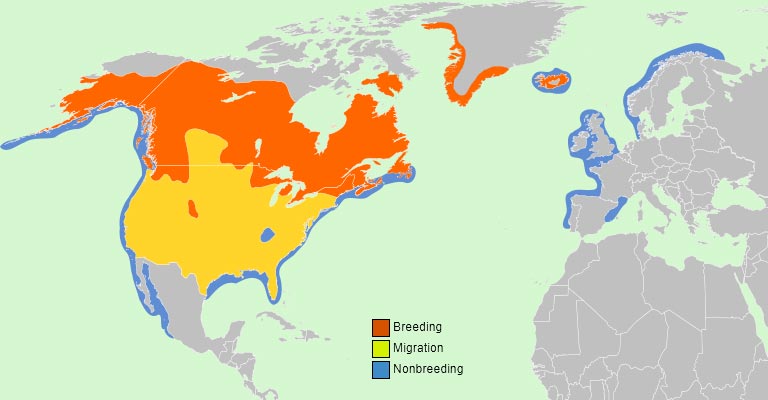
Common Loons breed across Canada and parts of the northern United States, with their range extending southward during winter to include coastal regions and large inland lakes in the United States.
Breeding
Breeding season typically begins in late spring to early summer when pairs establish territories on suitable lakeshores. Common Loons build their nests close to the water’s edge, constructing floating platforms of vegetation.
Females usually lay two eggs, which both parents take turns incubating. After hatching, the chicks are fed and protected by both parents until they fledge.
Diseases and Treatment
Common Loons are susceptible to a range of diseases, including avian botulism and lead poisoning from ingesting lead fishing tackle.
Treatment involves rehabilitation efforts by wildlife rehabilitators and organizations, including medical care and efforts to mitigate environmental contamination.
Conservation
The Common Loon faces various threats, including habitat loss, pollution, and disturbance from human activities such as boating and development.
Conservation efforts focus on protecting nesting habitats, reducing human disturbance, and monitoring populations to ensure long-term survival.
The life history of the Common Loon is characterized by its specialized adaptations, complex behaviors, and the challenges it faces in an ever-changing environment.
Understanding and protecting this iconic species is crucial for maintaining the health and biodiversity of North American freshwater ecosystems.
Nesting Habit of Common Loon
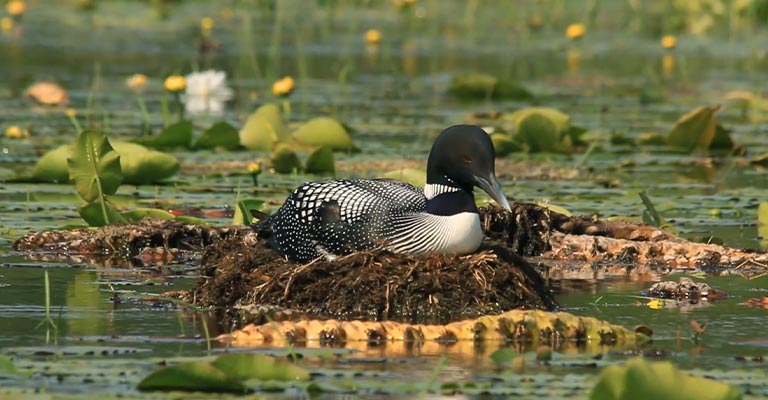
Go through the following table detailing the nesting habits of the Common Loon:
| Nesting Details | Common Loon |
| Clutch Size | Usually 2 eggs |
| Number of Broods | Typically 1 per season |
| Egg Length | Approximately 3.5 inches |
| Egg Width | Approximately 2 inches |
| Incubation Period | Around 26 to 30 days |
| Nestling Period | 9 to 11 weeks |
| Egg Description | Pale olive to brown, with dark spots and blotches |
| Nest Type | Floating platform on water, made of aquatic vegetation |
| Nest Location | Both parents care for eggs and young, alternate incubation shifts, and provide food and protection. |
| Incubation Responsibility | Shared by both parents |
| Nest Maintenance | Often rebuilt or repaired throughout the breeding season |
| Parental Care | Both parents care for eggs and young, alternate incubation shifts, and provide food and protection. |
These details offer insights into the reproductive behavior and nesting habits of the Common Loon, highlighting its adaptations to nesting in aquatic environments and the parental care involved in raising offspring.
Common Loons typically build floating platform nests concealed among shoreline vegetation near the water’s edge.
Each clutch usually consists of two eggs, which both parents take turns incubating for around 26 to 30 days. After hatching, the chicks spend 9 to 11 weeks in the nest, cared for by both parents.
The eggs are pale olive to brown with dark spots and blotches, blending with the surrounding environment. The nest may be rebuilt or repaired as needed throughout the breeding season.
This nesting strategy reflects the Common Loon’s adaptation to nesting in aquatic environments and the shared parental responsibilities of raising offspring.
5 Fun Facts About Common Loon
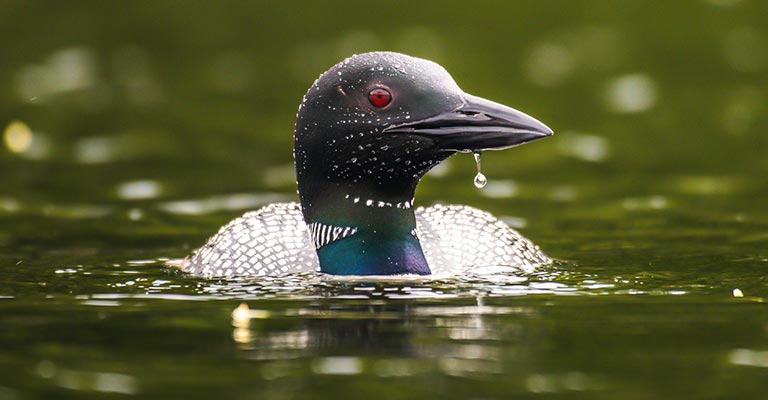
The Common Loon, with its striking appearance and haunting calls, is a fascinating bird species in North America’s freshwater lakes.
Beyond its distinctive characteristics, here are five fun facts about the Common Loon:
Expert Divers
Common Loons are exceptional divers, capable of descending to depths of over 200 feet and holding their breath for several minutes.
Their streamlined bodies and powerful legs enable them to pursue fish underwater with remarkable agility.
Incredible Migrators
These birds undertake impressive migrations, traveling thousands of miles between their breeding and wintering grounds.
Some individuals migrate from as far north as Canada to wintering areas along the coastlines of the United States.
Distinctive Calls
Common Loons are renowned for their haunting calls, which echo across the lakes they inhabit.
Their vocalizations include yodels, wails, and tremolos, serving as communication tools and territorial markers during the breeding season.
Family-Oriented
Common Loons exhibit strong family bonds, with both parents actively incubating eggs, feeding chicks, and protecting the nest.
They often engage in synchronized swimming and vocalizations as part of their courtship and bonding rituals.
Symbol of Wilderness
Revered for their beauty and charisma, Common Loons are considered symbols of wilderness and conservation.
Their presence in North America’s pristine lakeshores is a reminder of the importance of preserving natural habitats for future generations.
Wrapping Up
So, the Common Loon captivates us with its majestic presence, remarkable adaptations, and vital role in freshwater ecosystems.
From its expert diving skills and haunting calls to its devoted parental care and symbolic significance, the Common Loon reminds us of the beauty and fragility of our natural world.
By understanding and appreciating these fascinating birds, we can contribute to their conservation and ensure that future generations continue to marvel at their existence. Thank you very much.